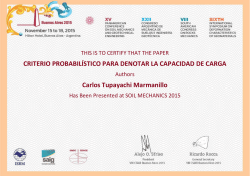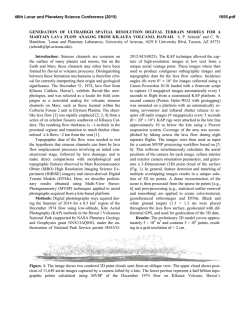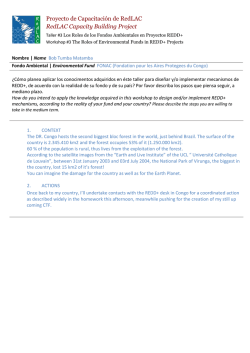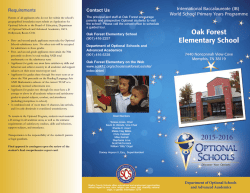
as a PDF
Catena 60 (2005) 239 – 253 www.elsevier.com/locate/catena Using geomorphologic mapping to strengthen natural resource management in developing countries. The case of rural indigenous communities in Michoacan, Mexico Gerardo Boccoa,*, Alejandro Velázquezb, Christina Siebec a Centro de Investigación en Ecosistemas, Universidad Nacional Autónoma de México/ Instituto Nacional de Ecologı́a, SEMARNAT, Mexico b Instituto de Geografı́a, Universidad Nacional Autónoma de México, Mexico c Instituto de Geologı́a, Universidad Nacional Autónoma de México, Mexico Received 29 March 2004; received in revised form 17 December 2004; accepted 20 December 2004 Abstract This paper describes the use of geomorphologic knowledge for resource management in rural areas of less developed countries. Specifically, we discuss the contribution of geomorphologic mapping (coupled with landscape knowledge) to natural resource management using geographic information systems (GIS) and remote sensing techniques. We describe a case study conducted at Nuevo San Juan Parangaricutiro, an indigenous forest community in the Paricutin area, in Michoacan, Mexico. The analysis described in this paper was used to improve the mapping of forest quality units, and to explore the relationships between land suitability and land utilisation requirements for potential diversification of economic activities in the indigenous community. The approach proved useful for the management of natural resources and was made operational by the actual managers of the resources. The community of Nuevo San Juan was granted the green certification (Smart * Corresponding author. Instituto Nacional de Ecologı́a, Periférico 5000, 2do. Piso, Colonia CuicuilcoInsurgentes, 04310 México City, Mexico. Tel./fax: +52 55 5424 6427. E-mail address: [email protected] (G. Bocco). 0341-8162/$ - see front matter D 2005 Elsevier B.V. All rights reserved. doi:10.1016/j.catena.2004.12.003 240 G. Bocco et al. / Catena 60 (2005) 239–253 Wood) by the Forest Stewardship Council (FSC) and produced a fully automated resource management plan. D 2005 Elsevier B.V. All rights reserved. Keywords: Geomorphologic surveying and mapping; Soil surveying and mapping; Geographic information systems; Natural resource management; Indigenous communities; Developing countries; Mexico 1. Introduction Geomorphologic mapping has been recognized as a valuable scientific tool from both theoretical and applied perspectives (Verstappen, 1983; Pasuto and Soldati, 1999; Andrzejewski, 2002). The role of mapping in geomorphology has also been related to recent advances in digital procedures, especially geographic information systems (GIS) (Vitek et al., 1996; Bocco et al., 2001a). The definition, delineation, and scientific value of homogeneous mapping units still receives research attention (see, among others, Guzzetti and Reichenbach, 1994; Al Bakri, 1996; Bernert et al., 1997; CEC, 1997; Omernik and Bailey, 1997; van Westen et al., 2000). In addition, landform mapping has straightforward practical meanings. The procedure is at the base of soil surveying and mapping because it provides soil sampling with a stratified spatial framework (FAO, 1988). This offers the opportunity to assess the role of soil, in support of agriculture, cattle-grazing and forest management activities, in a spatial context. The characteristics of the soils, as derived from an integrated landform–soil survey, determine the potential for land-use in a given area, and thus are at the core of any resource management plan. Resource management is vital in tropical areas because a large proportion of the population still relies on primary economic activities for subsistence, and thus exerts strong pressures on forests, water and soils. Resource management is a complex matter, particularly in developing countries. In Mexico, 80% of the entire forest resource is accessed by rural indigenous communities (Thoms and Betters, 1998; Bocco et al., 2001b), many surviving in different degrees of marginality. Forest resources play a key role (besides that of directly providing local producers with income and goods) in the provision of environmental services, especially carbon sequestration, water resources, prevention of landsliding and soil loss, among others. For instance, in 1998, a major proportion of Central American forest resources, crops, and infrastructure was destroyed during the Mitch hurricane catastrophe that killed thousands (USGS, 2002). Besides the strength of the meteor, the disaster showed the effects of deforestation and the extreme vulnerability of the rural populations affected see, e.g., Panizza (1996). Particular features in developing countries are the absence of relevant environmental data, the gaps in the existent data sets, or their obsolescence. Thus, the development of conceptual and spatial frameworks to contribute sound data to the management of natural resources in these conditions is relevant. Without such frameworks, adaptive ecosystem management (Vogt et al., 1997) would not be a feasible strategy for sustainable development (Sexton et al., 1998; Thoms and Betters, 1998; Velázquez et al., 2001a). G. Bocco et al. / Catena 60 (2005) 239–253 241 Sheng et al. (1997) addressed natural resource management from an automated watershed management approach, specifically formulated for developing countries. Our paper describes an approach to resource management in rural communities of less developed countries from a geomorphologic perspective. Specifically, we discuss the contribution of geomorphologic mapping (coupled with soil and landscape information) to natural resource management using geographic information systems (GIS) and remote sensing. We describe a case study developed at Nuevo San Juan Parangaricutiro, an indigenous forest community in the Paricutin area, in Michoacan, Mexico (Inbar et al., 1994; Velázquez et al., 2001a) (Fig. 1), in which landform-based mapping was used as a major input to the resource management plan of the community. As social and political organisations, forest communities in Mexico must, by law, submit every 10 years a management plan to the Ministry of the Environment in order to use their forest resource (Thoms and Betters, 1998); thus, capacity building in resource monitoring is important for such communities. The results of the plan, in addition, are useful to guide diversification efforts and land use planning. We developed a participatory (community–university) research project in cooperation with Fig. 1. Location map of the indigenous community in the State of Michoacan, Mexico. 242 G. Bocco et al. / Catena 60 (2005) 239–253 the community of Nuevo San Juan Parangaricutiro, following a specific request by the communal authorities. The overall project objective consisted of hands-on training of local technicians to generate and automate the geographic information needed to develop the natural resource management plan of the community (Bocco et al., 2001b). As a part of this program, geomorphologic mapping was aimed at improving forest quality mapping, and to explore the relationships between land suitability and land utilisation requirements for potential diversification of economic activities in the indigenous community. The objective of this paper is to describe how geomorphologic and soil surveying and mapping were carried out and how the resulting information was used for the above mentioned purposes by the community of Nuevo San Juan. We believe that this approach may be applicable to other rural communities in developing countries. 2. The study area Nuevo San Juan Parangaricutiro is an indigenous (Purepecha group) community located 15 km east of Uruapan (state of Michoacan, Fig. 1). The communal land is roughly 190 km2, whereas the forested area encompasses 120 km2; elevation varies between 1600 and 2300 m above sea level. Climate is temperate (Kfppen, as modified by Garcı́a, 1981), and rainfall (ca. 1000 mm, yearly mean) is seasonal; on the average, 80% of the precipitation occurs during summer, between May and October. All rock types and relief are of Quaternary volcanic origin (scoria cones, lava flows and pyroclastic plains are dominant); soils are derived from recent volcanic materials (Scatolin, 1996). The eruption of the Paricutin volcano (1943–1952) initiated andesitic–basaltic lava flows over an area of 24 km2 and volcanic ashes over an area of 350 km2 (Inbar et al., 1994). At present, the ash cover can be as 2 m thick within a radius of 6 km around the cone (field observations). The main land cover is characteristic of humid and sub-humid temperate forests (fir, pine and oaks are dominant). The area close to the Paricutin cone (covered by lava and ashes) is experiencing rapid re-colonization (Velázquez et al., 2001b). Land use includes subsistence agriculture (maize, chile, beans), extensive grazing, avocado and peach orchards, and forestry. The eruption of the Paricutin volcano affected villages, crops and forests of the community (Rees, 1970; Inbar et al., 1994), dramatically upsetting the life of peasants. Some years after the event they were granted other forested lands nearby, to which they moved and restarted community life. Currently, 1300 comuneros (who are granted rights on the communal land) and their families live in the community. The large majority inhabits the urban settlement (also called Nuevo San Juan), which is also the centre of the municipality, and where government offices, hospitals and schools are located. The total population of the municipality is around 15,000 inhabitants, of which approximately one third are indigenous people. Despite the ethnic language is only spoken by the elders (above 60 years old), traditions of community life, such as feasts, food and clothing, prevail among the majority. The main economic activity is the community’s forestry enterprise with some 850 indigenous employees earning wages above the minimum salary, an unusual fact in G. Bocco et al. / Catena 60 (2005) 239–253 243 rural Mexico. The community is well known for its sustained use of forest and the integrated management of derived goods (Alvarez-Icaza, 1993). Manufactured products (including wooden floors, furniture and resin), are commercialised into both the national and international markets. The community was granted the right to administer its own forest technical services in 1988, thus receiving complete control of the resource by the government. Nuevo San Juan is an example of a relatively small but powerful group of forest indigenous communities that have managed to use their resources in a sustained manner. 3. Method and techniques Landform analysis was regarded as the basic step for the inventory of natural resources and a first approximation to the definition of landscape units. These units describe both the relatively stable land components (geology, terrain, and soils in an integrated manner), as well as the less stable components whose rate of change in time is much faster (vegetation and land cover). Both sets of components stored in the databases of a GIS can be logically combined using the available spatial analytical tools (classification, overlaying, digital elevation modelling and slope calculations; Aronoff, 1989). Landform, as a concept, has not been used as a categorical level in a hierarchical system (such as the one developed by Zinck, 1989), but rather as a pragmatic term for a portion of the geographic space having similarities in rock-relief and soils (in the sense of terrain unit) or the above mentioned plus land-cover (in the sense of land unit). Because of their nature and type of contacts, landforms are more easily segmented than soils or vegetation, which tend to change along gradients (ecotones, soil transitions). Homogeneous mapping units allow data management and analysis using data base management technology and conventional data models in a GIS (vector, raster and relational; Aronoff, 1989). They can be used at different spatial and time scales for land evaluation procedures (Rossiter, 1990; FAO, 1993), landscape modelling and habitat conservation (Velázquez and Bocco, 1994). 3.1. Geomorphologic surveying Geomorphologic surveying and mapping were carried out using recent panchromatic, black and white aerial photointerpretation and terrain analysis at approximate scales of 1:25,000 and 1:50,000 (van Zuidam and van Zuidam-Cancelado, 1986). Landform mapping was based on the discrimination of (i) volcanic cones and lava flows according to their age (Segerstrom, 1950; Williams, 1950; Scatolin, 1996) and (ii) related units such as interlavic plains and volcanic foot-slopes. Tone, texture, and pattern considerations were used to guide photointerpretation. Slope morphology and morphometry, and drainage pattern analysis were derived from both topographic map (1:50,000 scale) interpretation and aerial photography. Landform delineation and related soil materials were intensively field verified at 120 sites. Both activities were performed by joint teams (community and university technical staffs) in the context of the handson training program. 244 G. Bocco et al. / Catena 60 (2005) 239–253 3.2. Geographic information system (GIS) procedures Every interpreted photograph was digitized and rectified using a mono-restitution approach (McCullough and Moore, 1995). Thus, a geomorphologic (vector) map was created and subsequently rasterised and combined with other data layers (Aronoff, 1989). A digital elevation model (DEM) was created by interpolation of 20-m interval contour lines digitized from the topographic map (Sheng et al., 1997). A slope gradient map was derived from the DEM using standard filtering techniques and classified into appropriate categories. The landform interpretation in vector format was subsequently displayed on the screen and wrapped on both the digital elevation model and the slope map to insure accuracy in contacts and to increase consistency (see Lopez-Blanco and Villers, 1995). A digital land cover-land use map was visually interpreted from an enhanced Landsat Thematic Mapper (1998) colour composition using one infrared and two visible bands (TM 4, 3 and 2). Enhancement consisted of band stretching and edge enhancement filtering to improve detection of land cover variability. Land cover categories thus delineated were refined using field-verified, 1:25,000-scale aerial photographs. Geomorphic units were cartographically overlain on soils (see below) and land cover data to quantify dominant soil and cover per landform category. The procedure did not aim at defining mechanically the relationships between landform, soils and land cover. 3.3. Soil surveying and mapping A semidetailed soil survey was conducted following standard procedures (Breimer et al., 1986; Schlichting et al., 1995). Geomorphologic units, litho-chronologic data (Williams, 1950) and ash deposition maps (Segerstrom, 1950), and own field Table 1 Litho-chronologic sequence A. Lavic and pyroclastic rocks of various origins and composition, Early Quaternary (?), at the South and West of the study area. 1. Zumpimito Formation, with acid to intermediate lavas, volcanic tuffs and lahars, highly weathered, at the South of the study area. 2. Andesitic lava flows of the Tancitaro stratovolcano, underlaying footslope units, at the Southwest of the study area. B. Late Pleistocene and Holocene andesitic–basaltic and basaltic (olivinic) lavic and pyroclastic rocks, at the Centre and North of the study area. 1. Pleistocene andesites of Huanarucua Mesa 2. Late Pleistocene or Holocene (?) olivinic basalts and basaltic–andesites of several monogenetic cones, at the Centre-east and North of the study area. 3. Holocene basaltic-andesites of several monogenetic cones at the Centre-east and North of the study area (ca. 2000 years old, Williams, 1950). 4. Basaltic-andesites of the Paricutin volcano, at the Centre-west (50 years old). C. Alluvial and colluvial deposits of volcanic origin Sources: Williams (1950) and Segerstrom (1950); aerial photointerpretation and field work. G. Bocco et al. / Catena 60 (2005) 239–253 245 observations were used to decide upon a stratified soil sampling strategy. In each spatial unit we described at least 1 and up to 10 soil profiles, depending on the surface area covered by the unit. A total of 34 profiles were surveyed. Soil boundaries were further crossed checked through 87 augering sites. Soil profiles were described following Siebe et al. (1996), whereas soil was classified following FAO (1988). The results of soil profile description and laboratory analyses are provided elsewhere (Siebe et al., 2003). 4. Results 4.1. Surveying and mapping Volcanic materials, identified according to their age and lithology, encompass lavic and pyroclastic rocks of the Pleistocene and Holocene (Table 1). Landforms were grouped into five classes each characterized by typical soil types and land cover 786000 789000 792000 795000 798000 2166000 LEGEND N 21480000 2151000 2154000 2157000 2160000 2163000 Scoria cones Lavic domes Andesitic lava flows, summit surfaces Andesitic lava flows, denudational slopes Andesitic-basaltic and basaltic lava flows, summit surfaces Andesitic-basaltic and basaltic lava flows, denudational slopes Basaltic-andesites of Paricutin Accumulative volcanic footslopes Accumulative plains with fluvially reworked ashes Accumulative plains with fall-out (in situ) Paricutin ashes Erosional valleys Hysopacks (15 cm) Hysopacks (25 cm) Hysopacks (50 cm) Hysopacks (1 m) Hysopacks (2 m) Cartographic Projection: 2142000 2145000 Ellipsoid: Clarke 1866 Projection: UTM zone13 Datum: North American 1927 (NAD27) Cartographic Edition: 0 786000 789000 792000 795000 6 km José Antonio Navarrete Pacheco 798000 Fig. 2. Geomorphologic map based on field verified aerial photointerpretation. See complete legend and description in Table 2. 246 G. Bocco et al. / Catena 60 (2005) 239–253 (Fig. 2, Table 2): volcanic cones, lava flows, footslopes, plains and valleys. Soil types surveyed (Siebe et al., 2003) were lithic and andi-mollic Leptosols on lavic flows, vitri-eutric Regosols on recent ash deposits, mollic Andisols on older ash deposits, and vitri-eutric Fluvisols on fluvial plains (Fig. 3, Table 3). Major land cover-land use types included were temperate mixed forest (pines and oaks), rain-fed agriculture, orchards, and cattle grazing. An integrated map based on landforms was defined through interpretation, automatic classification, and cartographic overlaying (Fig. 2). The mapping units and subunits (described in terms of slope characteristics and processes, lithology, dominant cover-use, and major soil types) are presented in Fig. 4. The central and northern area is typical of Holocene and recent volcanic landscapes, with very well preserved monogenetic cones, lava flows, and plains with a pyroclastic cover. Thus the drainage system is either incipient and disintegrated or even nonexistent, with strong infiltration in ashes and blocky lavas. This area is mainly devoted to forestry, and most of the income of the community originates here. Accelerated erosion processes may occur on gently sloping areas with a conspicuous Paricutin ash cover. The southern area is typical of Pleistocene volcanic environments with relatively older andesitic lava flows and volcanic footslopes, well-developed soils and radial to subdendritic drainage systems. Because of the absence of recent ashes from the Paricutin, the forest cover of this area was removed for agricultural purposes (rain-fed and orchards) and grazing. Subsistence Table 2 Geomorphic units with dominant soils and cover types 1. Late Pleistocene and Holocene andesitic and basaltic monogenetic cones with a pyroclastic cover, with Andisols or Regosols and pine forest. 1.1 Scoria cones, mainly Holocenic, with steep (N30%) rectilinear slopes. 1.2 Late Pleistocene lavic domes with steep convex slopes. 2. Late Pleistocene, Holocene and recent andesitic, basaltic-andesites and basaltic lava flows. 2.1 Late Pleistocene, andesitic lava flows, with a deep (N1 m), weathered pyroclastic cover, with andosols, under rain-fed agriculture, grazing or avocado orchards, with apparent interrill erosion and incipient gully erosion. a. Summit surfaces, slightly convex, gentle (b5%) slopes b. Denudational slopes, rectilinear to convex, medium (10% to 30%) slopes. 2.2 Late Pleistocene and recent andesitic–basaltic and basaltic lava flows, with a moderate (0.5 to 1 m), weathered pyroclastic cover, occasionally covered by Paricutin ash, with Andisols or Regosols, with pine forest and occasionally peach orchards. a. Summit surfaces, rectilinear, gentle (b5%) slopes b. Denudational slopes, irregular, variable (N5% to 30%) slopes. 2.3 Basaltic-andesites of Paricutin, unweathered and uncovered; chaotic, blocky (Aa type) lava. 3. Accumulative volcanic footslopes of Tancitaro stratovolcano, with an Early Quaternary andesitic bedrock, rectilinear, medium (b15%) slopes, with a deep (N1 m), weathered pyroclastic cover, with andosols, under rainfed agriculture or grazing, with interrill erosion and incipient gully erosion. 4. Accumulative plains, with Holocene and recent pyroclastic material, gentle (b5%) or almost flat slopes, with Fluvisols or Regosols. 4.1 With fluvially reworked ashes, under rain-fed agriculture. 4.2 With fall-out (in-situ) Paricutin ash, under afforestation (in weathered bedrock) or uncovered. 5. Erosional valleys on Late Tertiary–Early Quaternary (?), highly weathered, volcanic materials, rectilinear, steep (N30%) slopes, with andosols and temperate (fir and cloud) forest. Source: aerial photointerpretation and field verification. G. Bocco et al. / Catena 60 (2005) 239–253 789000 795000 792000 798000 2166000 786000 247 LEGEND N 2163000 Mollic Andisols on Pario and related cones Mollic Andisols on Pleistocenic andesites with relatively cool temperate climate Mollic Andisols on Pleistocenic andesites with relatively warm temperate climate Vitri-eutric Regosols on 30-60 cm thick Paricutin ashes, overlaying buried mollic or haplic Andosols Vitri-eutric Regosols on > 60 cm thick Paricutin ashes, overlaying buried mollic or haplic Andosols Lithic Leptosols on lava flows of Paricutin volcano E 2160000 D F 2154000 2157000 Andi-mollic and lithic Leptosols associated with mollic Andisols with a deep lithic phase on lava flows of Prieto and San Nicolas volcanic cones Vitri-eutric Fluvisols on accumulative plains with fluvially reworked tephra Canyons G 2151000 A Sampling sites for soil profiles 21480000 H C I B 2145000 K 2142000 Cartographic Projection: 0 Ellipsoid: Clarke 1866 Projection: UTM zone13 Datum: North American 1927 (NAD27) Cartographic Edition: 786000 789000 792000 6 km 795000 José Antonio Navarrete Pacheco 798000 Fig. 3. Soil map based on geomorphologic units and soil profile field description (see Table 3). agriculture, avocado production for the national market, and cattle for the local market are produced here. The areas where accelerated erosion processes are apparent, according to field-verified photointerpretation, are some of the slopes on andesitic lava flows under rainfed agriculture and a portion of the footslopes under grazing. Soil properties and spatial distribution of soil material are largely determined by the age of the ash deposits from which they originated and the stratification over other previous volcanic lava or tephra; major soil forming process is andosolization. Limitations for agricultural use and plant growth are mainly due to lack of available nitrogen and phosphorus, and poor moisture retention capacity, especially on recent ash deposits. 5. The community’s use of landform classification The geomorphologic units described in this paper were used to (i) improve the mapping of forest quality units (site evaluation for forest use) and (ii) analyse the relationship between land suitability and land utilisation requirements (a procedure 248 G. Bocco et al. / Catena 60 (2005) 239–253 Table 3 Soils and dominant landscape positions 1. Andisols 1.1 Mollic Andisols on Pario and related cones 1.2 Mollic Andisols on Pleistocenic andesites with a relatively cool temperate climatea 1.3 Mollic Andisols on Pleistocenic andesites with a relatively warm temperate climatea 2. Regosols 2.1 Vitri-eutric Regosols on 30–60 cm thick Paricutin ashes, overlaying buried mollic or haplic Andisols. 2.2 Vitri-eutric Regosols on N60 cm thick Paricutin ashes, overlaying buried mollic or haplic Andisols. 3. Leptosols 3.1 Lithic Leptosols on lava flows of Paricutin volcano 3.2 Andi-mollic and lithic Leptosols associated with mollic Andisols with a deep lithic phase on lava flows of Prieto and San Nicolas volcanic cones 4. Fluvisols 4.1 Vitri-eutric Fluvisols on accumulative plains with fluvially reworked tephra. Sources: aerial photointerpretation and field verification. a No quantitative climatic data are available for this area, thus the differentiation is mostly based on field observation. described as land evaluation, FAO, 1993) for potential diversification of economic activities (including the adoption of ecotourism as a source of income). Every technique was applied in the framework of the hands-on training activity; thus the entire surveying and mapping exercise also served for capacity building purposes. The final outcomes were the official forest management plan for the Ministry of the Environment and the implementation of a GIS unit for data management and analysis operated by two members of the community (Bocco et al., 2001b). 5.1. Improving forest quality mapping The map (Fig. 5) was based on intensively field checked aerial photointerpretation of forest cover at 1:25,000 approximate scale. Forest cover was mapped according to texture of canopy. Quality was preliminary attached to cover density; three quality classes were defined in this basis. It was assumed that good forest cover was related to high forest quality for logging purposes. Ancillary data were landforms, soils, and vegetation classifications. The landform–soil relationship was used to refine the classes defined through photointerpretation. A rule was defined in such a way that, for example, the polygons photo-identified as belonging to the high quality class should have, in addition to a good cover (not less than 80% as measured on the photo), relatively gentle slopes (b10%), deep (ca. 1 m) soils, and absence of Paricutin ash, all data emanating from the geomorphologic survey, conveniently manipulated in the GIS. The units defined were further field-characterized using a stratified systematic sampling design (Velázquez et al., 2003). On the whole, 136 forest stands, comprising 1271 forest sub-stands were recognized. This included the surveying of 4662 sites of approximately 1000 m2 per site. On the basis of the forest quality map, the community can plan which tracts of forest land will be managed every season during the following 10 years. In addition, the fragility of volcanic soils was classified as a risk if unsustainable forest management takes over the current approach. G. Bocco et al. / Catena 60 (2005) 239–253 geomorphic unit lithology lava flow Paricutin basaltic andesite accumulative plains Historic (1952) coverage primary succesion bare surface with pine afforestation lithic Leptosol vitri-eutric Regosol soil lava flows of older accumulative volcanoes covered by plains Paricutin ash falls in situ fall-out Paricutin ash age Historic (1952) profile 0 249 A(h) R in situ fall-out Paricutin ash covering former soils Historic over Holocene peach orchards or pine forest vitri-eutric Regosol over mollic Andosol D F A(h) AC fluvially reworked ash fall deposits Historic (1952-66) pasture vitri-eutric Fluvisol C C C E Ah C1 C2 C3 C4 C5 2Bw 2AB 2Bw 100 cm Fig. 4. Geomorphologic units and their relation to soil types in the study area. 5.2. Land suitability for selected land-use types Intensification of diversified economic activities (other than conventional forestry) was assessed through automated land evaluation procedures (Rossiter, 1990; FAO, 1993). Geomorphologic units and related soils were evaluated in terms of their qualities versus land use type requirements (Rosete, 1998). Land use types evaluated were rain-fed maize, perennial grasslands (for cattle grazing) and orchards (peach and avocado) and suitable land uses were suggested per mapping unit on the basis of selected soil qualities (Fig. 6). Thus, the procedure allowed the producers to identify alternative land use types and allocate a proper land unit to each of them. For instance, for rain-fed agriculture, soil quality was described in terms of 11 properties (derived from the survey), out of which soil depth, (fresh) ash depth and elevation were the crucial ones to meet the requirements of the land use type. In this way, traditional agriculture was reconsidered by producers as a 250 G. Bocco et al. / Catena 60 (2005) 239–253 786000 789000 792000 795000 798000 2166000 LEGEND N 21480000 2151000 2154000 2157000 2160000 2163000 High forest quality Medium forest quality Low forest quality Reforested areas Grasslands Rain-fed agriculture Orchard Paricutin ashes Particutin lava San Juan ruin Human settlement Cartographic Projection: 2142000 2145000 Ellipsoid: Clarke 1866 Projection: UTM zone13 Datum: North American 1927 (NAD27) Cartographic Edition: 0 786000 789000 792000 795000 6 km José Antonio Navarrete Pacheco 798000 Fig. 5. Forest quality map based on landforms and forest photo texture. feasible farming system for maize and bean production in the southeast portion of the community (Pulido and Bocco, 2003). 6. Conclusions Landscape surveying and mapping techniques based on geomorphologic analysis, coupled with GIS and remote sensing procedures as well as a systematic training program, were useful tools for natural resource management in an indigenous community in a developing country. These tools were actually used by the managers of the resources. The community of Nuevo San Juan was granted the green certification (Smart Wood) by the Forest Stewardship Council (FSC). This distinction is awarded to social enterprises whose forestry activities fulfil several requirements concerning ecologically sound forest management. Indigenous communities may adequately combine old traditions of community life with entrepreneurial agroforestry activities in the context of natural resource planning using up- G. Bocco et al. / Catena 60 (2005) 239–253 786000 789000 792000 795000 251 798000 2166000 LEGEND N 21480000 2151000 2154000 2157000 2160000 2163000 Forestry Forestry and cattle-grazing Cattle-grazing Forest and orchard plantations Paricutin lava Cartographic Projection: 2142000 2145000 Ellipsoid: Clarke 1866 Projection: UTM zone13 Datum: North American 1927 (NAD27) Cartographic Edition: 0 786000 789000 792000 6 km 795000 José Antonio Navarrete Pacheco 798000 Fig. 6. Land suitability for selected land uses. to-date technology and geomorphologic surveying. In this context, geomorphologic knowledge must be user-oriented to insure proper application. Because of the nature of landforms and their role as a landscape component, geomorphologic surveying proved extremely useful for resource inventory, analysis and management in areas where resource knowledge is scarce, non updated or even absent. In operational terms, the success of this approach is strongly based on the social organisation of the indigenous community. The social group ought to be well organised if efforts and investments are to be capitalised and reproduced. This is crucial for potential model extrapolation to similar rural communities in developing countries. Acknowledgements We are grateful to the Technical Department of the indigenous community of Nuevo San Juan for continuous support. Silvia Sánchez, Pedro Avilés and Kumiko Shimada assisted in laboratory soil analyses. Antonio Guadarrama edited the final versions of 252 G. Bocco et al. / Catena 60 (2005) 239–253 digital maps. Funding sources were the University of Mexico (PAPIIT, project IN 101196) and the United States Fish and Wildlife Service (USFWS-Vida Silvestre sin Fronteras). The criticism to the first version of the manuscript by J.A. Zinck and M. Meadows, which contributed to improving the paper, is highly appreciated. References Al Bakri, D., 1996. A geomorphological approach to sustainable planning and management of the coastal zone of Kuwait. Geomorphology 17 (4), 323 – 337. Alvarez-Icaza, P., 1993. Forestry as a social enterprise. Cultural Survival 17 (1), 45 – 47. Andrzejewski, L., 2002. The impact of surges on the ice-marginal landsystem of Tungnaárjfkull, Iceland. Sedimentary Geology 149 (1–3), 59 – 72. Aronoff, S., 1989. Geographic information systems. A management perspective. WDL, Ottawa. Bernert, J., Eilers, J., Sullivan, T., Freemark, K., Ribic, C., 1997. A quantitative method for delineating regions. Environmental Management 21 (3), 405 – 420. Bocco, G., Velázquez, A., Mendoza, M., 2001a. GIS-based regional geomorphological mapping for land-use planning. Geomorphology 39, 211 – 219. Bocco, G., Rosete, F., Bettinger, P., Velázquez, A., 2001b. GIS program development with community participation in a developing country. Journal of Forestry 99 (6), 14 – 19. Breimer, R.F., van Kekem, A.J., Van Reuler, H., 1986. Guidelines for soil survey and land evaluation in ecological research. MAB Technical Notes, vol. 17. UNESCO, Paris. CEC (Commission for Environmental Cooperation), 1997. Ecological regions of North America: toward a common perspective. CEC, Montreal. FAO (Food and Agriculture Organization), 1988. Soil map of the world. Revised legend. World Soil Resources Reports, vol. 60. FAO-UNESCO, Paris. FAO (Food and Agriculture Organization), 1993. FESLM. An International Framework for Evaluating Sustainable Land Management. World Soil Resources Reports, vol. 73. FAO, Rome. Garcı́a, E., 1981. Modification of the Kfppen climatic system in Mexico. UNAM (in Spanish). Guzzetti, F., Reichenbach, P., 1994. Towards a definition of topographic divisions for Italy. Geomorphology 11 (1), 57 – 74. Inbar, M., Lugo, J., Villers, L., 1994. The geomorphological evolution of the Paricutin cone and lava flows, Mexico, 1943–1990. Geomorphology 9, 57 – 76. Lopez-Blanco, J., Villers, L., 1995. Delineating boundaries of environmental units for land management using a geomorphological approach and GIS: a study in Baja California, Mexico. Remote Sensing of Environment 53, 109 – 117. McCullough, D., Moore, K., 1995. Issues and methodologies in integrating aerial photography and digital base maps. Geo Info Systems 5 (3), 46 – 48. Omernik, J., Bailey, R., 1997. Distinguishing between watersheds and ecoregions. Journal of the American Water Resources Association 33 (5), 935 – 949. Panizza, M., 1996. Environmental geomorphology. Elsevier, Amsterdam. Pasuto, A., Soldati, M., 1999. The use of landslide units in geomorphological mapping: an example in the Italian Dolomites. Geomorphology 30 (1–2), 53 – 64. Pulido, J., Bocco, G., 2003. The traditional farming system of a Mexican indigenous community. Geoderma 111 (3–4), 249 – 265. Rees, J.D., 1970. Paricutin revisited: a review of man’s attempt to adapt to ecological changes resulting from volcanic catastrophe. Geoforum 4, 7 – 25. Rosete, F., 1998. Data base management and land evaluation in Nuevo San Juan Parangaricutiro. Unpublished Msc thesis. University of Michoacan, Mexico. Rossiter, D.G., 1990. ALES: a framework for land evaluation using a microcomputer. Soil Use and Management 6 (1), 7 – 20. Scatolin, M., 1996. Studio Geologico e Morfometrico del Settore Centro Occidentale della Meseta Tarasca. Unpublished Msc thesis. University of Milan-University of Michoacan, Milan-Morelia. G. Bocco et al. / Catena 60 (2005) 239–253 253 Schlichting, E., Blume, H., Stahr, K., 1995. Bodenkundliches Praktikum, 2nd ed. Pareys Studientexte 81. Blackwell Wissenschafts-Verlag, Berlin. Segerstrom, K., 1950. Erosion Studies at the Paricutin, state of Michoacan, Mexico. Geological Survey Bulletin, vol. 965-A. USGS, Washington. Sexton, W.T., Dull, C.W., Szaro, R.C., 1998. Implementing ecosystem management: a framework for remotely sensed information at multiple scales. Landscape and Urban Planning 40, 173 – 184. Sheng, T., Barrett, R., Mitchell, T., 1997. Using geographic information systems for watershed classification and rating in developing countries. Journal of Soil and Water Conservation 52 (2), 84 – 89. Siebe, Ch., Jahn, R., Stahr, K., 1996. Manual para la descripción y evaluación ecológica de suelos en el campo. Publicación Especial, vol. 4. Sociedad Mexicana de la Ciencia del Suelo, A.C. Chapingo, Mexico. Siebe, Ch., Bocco, G., Espinoza, F., Velásquez, Alejandro, 2003. Suelos: distribución, caracterı́sticas y potencial de uso. In: Velázquez, A., Torres, A., Bocco, G. (Eds.), Las Enseñanzas de San Juan. INE, Mexico. Thoms, C.A., Betters, D., 1998. The potential for ecosystem management in Mexico’s forest ejidos. Forest Ecology and Management 103, 149 – 157. U.S.G.S. (United States Geological Survey), 2002. Activities in Support of the Hurricane Mitch Reconstruction Program. Executive Summary. http://mitchnts1.cr.usgs.gov/publications/USGS_MITCH_EXEC_SUM.pdf. van Westen, C., Soeters, R., Sijmons, K., 2000. Digital geomorphological landslide hazard mapping of the Alpago area, Italy. International Journal of Applied Earth Observation and Geoinformation 2 (1), 51 – 60. van Zuidam, R.A., van Zuidam-Cancelado, F.I., 1986. Aerial-photointerpretation in terrain analysis and geomorphologic mapping. Smits, The Hague. Velázquez, A., Bocco, G., 1994. Modelling conservation alternatives: a case study of the volcano rabbit. ITC Journal 3, 197 – 204. Velázquez, A., Bocco, G., Torres, A., 2001a. Turning scientific approaches into practical conservation actions. The case of Nuevo San Juan Parangaricutiro, Mexico. Environmental Management 27 (5), 655 – 665. Velázquez, A., Giménez de Azcárate, J., Escamilla, M., Bocco, G., van der Maarel, E., 2001b. Vegetation dynamics on Paricutin, a recent Mexican volcano. Acta Phytogeographica Suecica 85, 71 – 88. Velázquez, A., Fregoso, A., Bocco, G., Cortez, G., 2003. Strengthening long term forest management. The use of a landscape approach in Mexican forest indigenous communities. Interciencia 28 (11), 632 – 638. Verstappen, H.Th., 1983. Applied geomorphology. Elsevier, Amsterdam. Vitek, J.D., Giardino, J., Fitzgerald, J., 1996. Mapping geomorphology: a journey from paper maps, through computer mapping to GIS and Virtual Reality. Geomorphology 16 (3), 233 – 249. Vogt, K., Gordon, J., Wargo, J., Vogt, D., Asbjornsen, H., Palmioto, P., Clark, H., O’Hara, J., Keeton, W., PatelWeynand, T., Witten, E., 1997. Ecosystems. Balancing Science with Management. Springer, New York. Williams, H., 1950. Volcanoes of the Paricutin region, Mexico. Geological Survey Bulletin, vol. 965-B. USGS, Washington. Zinck, J.A., 1989. Physiography and soils. Internal Publication. ITC, Enschede.
© Copyright 2026







